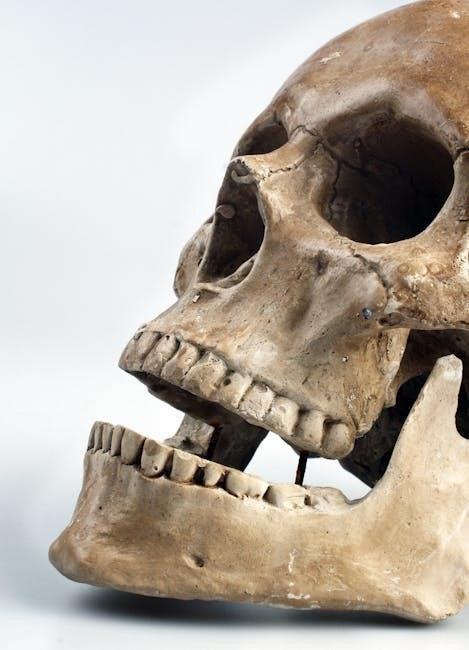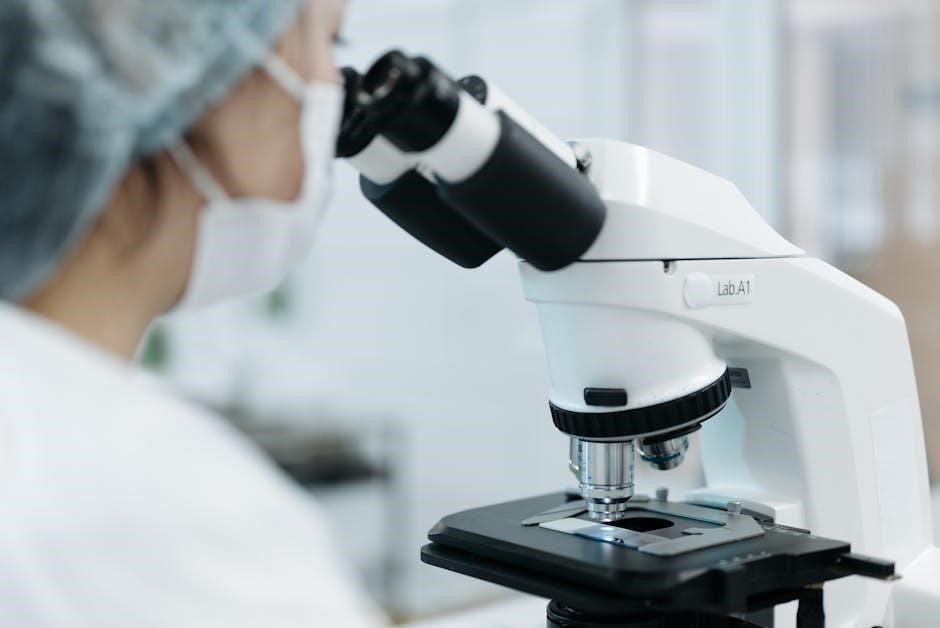Biology is the scientific study of life, exploring its diversity, structure, and interactions. It examines key concepts like cells, genetics, and ecosystems, providing insights into living organisms and their roles in nature. This foundation is essential for understanding life’s complexity and addressing real-world challenges in health, environment, and conservation.
1.1 Definition of Biology
Biology is the scientific study of life and living organisms, encompassing their structure, function, growth, evolution, and taxonomy. It explores life at various levels, from molecules and cells to ecosystems, focusing on processes that sustain life. Key areas include genetics, ecology, and evolution, offering insights into biodiversity and environmental interactions. Biology is an interdisciplinary field, integrating chemistry, physics, and Earth sciences to understand life’s complexity. It provides foundational knowledge for medicine, conservation, and sustainability, making it vital for addressing global challenges and improving human understanding of the natural world.
1.2 Key Concepts in Biology
Central to biology are concepts such as cells, genetics, and evolution. Cells are the basic units of life, while genetics explains heredity and variation. Evolution describes how species change over time. Additionally, energy flow, ecosystems, and homeostasis are fundamental, illustrating how life interacts and adapts. These concepts form the framework for understanding biological processes, from molecular mechanisms to ecological systems. Mastery of these ideas is crucial for analyzing living organisms and their roles in diverse environments, providing a solid foundation for advanced study and problem-solving in biology.
1.3 Branches of Biology
Biology encompasses various branches, each focusing on specific aspects of life. Botany studies plants, while zoology explores animals. Ecology examines interactions between organisms and their environment. Genetics delves into heredity and DNA, and anatomy investigates the structure of living beings. Physiology focuses on functions and processes, such as growth and reproduction. Biochemistry explores chemical processes within organisms, and molecular biology examines life at the molecular level. Evolutionary biology traces the history of species, and marine biology studies aquatic life. Each branch provides unique insights, collectively advancing our understanding of life’s diversity and complexity.
1.4 Importance of Studying Biology
Studying biology is crucial for understanding life processes and addressing global challenges. It provides insights into health, disease prevention, and medical advancements. Biology informs environmental conservation, sustainable practices, and food production. Knowledge of genetics, ecosystems, and evolution equips us to tackle issues like climate change and biodiversity loss. It fosters innovation in biotechnology, agriculture, and medicine. Understanding biology empowers individuals to make informed decisions about their health and the planet, contributing to a sustainable future. Its applications are vast, making it an essential field for solving real-world problems and improving quality of life.

Cells and Cellular Structure
Cells are the basic units of life, with cell theory explaining their function and reproduction. Cellular structures like membranes, organelles, and the cell cycle are essential for life processes.
2.1 Cell Theory and Components
Cell theory states that all living organisms are composed of cells, which are the fundamental units of life. Cells are responsible for reproduction, growth, and maintaining life’s functions. Key components include the cell membrane, cytoplasm, and genetic material. The cell membrane regulates the movement of substances, while the cytoplasm contains organelles essential for metabolic processes. Genetic material, such as DNA, carries hereditary information. Understanding these components is crucial for studying cellular biology, as cells are the building blocks of life, enabling organisms to function and interact with their environment effectively.
2.2 Cell Membrane and Transport
The cell membrane is a semi-permeable structure composed of a phospholipid bilayer with embedded proteins. It regulates the movement of substances in and out of the cell. Passive transport, such as diffusion and osmosis, requires no energy, while active transport involves energy expenditure to move molecules against concentration gradients. Vesicular transport, including endocytosis and exocytosis, facilitates the transfer of larger particles. Understanding these mechanisms is vital for comprehending how cells maintain homeostasis and interact with their environment. Proper membrane function ensures the cell’s internal balance and efficient exchange of nutrients, waste, and signaling molecules, which are essential for survival and cellular processes.
2.3 Cellular Organelles and Functions
Cellular organelles are specialized structures within cells that perform specific functions essential for survival. The nucleus houses genetic material and regulates gene expression. Mitochondria generate energy through ATP production. Ribosomes synthesize proteins, while the endoplasmic reticulum processes and transports proteins and lipids. The Golgi apparatus modifies, sorts, and packages proteins for distribution. Lysosomes contain digestive enzymes for breaking down waste and cellular debris. The cytoskeleton provides structural support, aids in transport, and maintains cell shape. Each organelle works together to ensure proper cellular function, enabling growth, reproduction, and response to environmental changes. Understanding their roles is fundamental to grasping cellular biology and its processes.
2.4 Cell Division and the Cell Cycle
The cell cycle consists of phases G1, S, G2, and M. In G1, the cell grows and prepares for DNA replication. During S phase, DNA replicates, ensuring genetic material is duplicated. G2 allows the cell to repair DNA errors and prepare for division. The M phase includes mitosis and cytokinesis, where the cell divides into two daughter cells. Regulation of the cell cycle ensures proper timing and prevents uncontrolled growth, which could lead to cancer. Understanding the cell cycle is crucial for studying cellular reproduction, growth, and repair in organisms.

Genetics and Heredity
Genetics and heredity explore how traits are inherited through genes and DNA; Key concepts include Mendelian laws, gene expression, and mutations, shaping biodiversity and individual characteristics.
3.1 Mendelian Inheritance
Mendelian inheritance, discovered by Gregor Mendel, explains how genes are passed down through generations. It introduces principles like segregation and independent assortment, which determine trait distribution in offspring. These laws form the basis of modern genetics, showing how dominant and recessive alleles interact. Understanding Mendelian inheritance is crucial for predicting genetic probabilities and analyzing family traits. This concept is fundamental in biology, providing insights into heredity patterns and the transmission of genetic information across generations.
3.2 DNA Structure and Replication
DNA (deoxyribonucleic acid) is a double helix structure composed of nucleotides, each containing a sugar, phosphate, and nitrogenous base. The sequence of these bases determines genetic information. Replication is semiconservative, meaning each new DNA molecule retains one original strand. Key enzymes like helicase unwind DNA, DNA polymerase synthesizes new strands, and ligase seals nicks. This precise process ensures genetic continuity across generations, making it fundamental to life and heredity. Understanding DNA structure and replication is essential for grasping genetic mechanisms and processes like mutation and repair.
3.3 Mutations and Genetic Variations
Mutations are changes in DNA sequences that can occur spontaneously or due to environmental factors like radiation or chemicals. They may alter gene function, leading to variations in traits. Types include point mutations (substitutions, additions, or deletions) and chromosomal mutations (changes in structure or number). Genetic variations arise from mutations and recombination, contributing to biodiversity. While some mutations are harmless, others can cause diseases or confer advantages. Understanding mutations is crucial for studying evolution, genetic disorders, and personalized medicine. They highlight the dynamic nature of genetic material and its role in adaptation and diversity across organisms, making them a key focus in genetics and biotechnology.
3.4 Gene Expression and Regulation
Gene expression involves the translation of genetic information from DNA to proteins, essential for cellular functions. It begins with transcription, where DNA is copied into mRNA, followed by translation, where ribosomes synthesize proteins. Regulation occurs at multiple levels to ensure genes are expressed appropriately. Transcriptional regulation involves promoters, operators, and regulatory proteins like activators and repressors, which control RNA polymerase binding. Post-transcriptional regulation includes microRNAs that inhibit mRNA translation. Additionally, chromatin structure and epigenetic modifications, such as DNA methylation and histone acetylation, influence gene accessibility and expression. Environmental factors like nutrients and toxins can also modulate gene activity, highlighting the dynamic interplay between genes and their surroundings. Understanding these mechanisms is crucial for studying development, disease, and cellular specialization.

Evolution and Natural Selection
Evolution explores how species diversify over time through natural selection, genetic drift, and other mechanisms. It explains biodiversity and adaptation, supported by fossil records and DNA evidence.
4.1 Mechanisms of Evolution
Evolution occurs through several key mechanisms, including natural selection, genetic drift, mutation, and gene flow. Natural selection favors traits enhancing survival and reproduction. Genetic drift introduces random changes in allele frequencies. Mutations create new genetic variations, while gene flow transfers genes between populations. These processes collectively drive speciation and biodiversity, shaping life’s diversity over time.
4.2 Evidence for Evolution
The evidence for evolution is extensive and multifaceted. Fossil records demonstrate the gradual emergence and diversification of life forms over time. Comparative anatomy and embryology reveal homologous structures, indicating common ancestry. Molecular biology shows similarities in DNA and proteins across species, supporting evolutionary relationships. Additionally, biogeography explains the geographic distribution of species, and observable evolutionary changes, such as antibiotic resistance in bacteria, provide direct evidence. These lines of evidence collectively confirm that evolution is the fundamental process shaping life on Earth.
4.3 Speciation and Phylogeny
Speciation is the process by which new species emerge, often due to reproductive isolation. Mechanisms include geographic barriers, genetic drift, and selection pressures. Phylogeny studies evolutionary relationships, constructing trees that map how species diverge over time. Molecular data, such as DNA sequences, help reconstruct these histories, showing how traits evolve. Understanding speciation and phylogeny reveals biodiversity’s origins and dynamics, linking evolution to the diversity of life on Earth. These concepts are central to biology, explaining how and why species change and diversify.
4.4 Human Evolution and Genetics
Human evolution explores the origins and development of Homo sapiens, tracing ancestry through fossil records and genetic data. Key milestones include bipedalism, brain expansion, and tool use. Genetics reveals how mutations, natural selection, and migration shaped human diversity. Recent discoveries highlight genetic variations influencing traits like skin color and disease resistance. Studies of ancient DNA, such as Neanderthal and Denisovan genomes, show interbreeding events, enriching modern human diversity. Understanding human evolution and genetics provides insights into our species’ adaptability, migration patterns, and susceptibility to diseases, advancing personalized medicine and our connection to evolutionary history.

Ecology and Ecosystems
Ecology studies interactions among organisms and their environment, focusing on ecosystems, biomes, energy flow, and nutrient cycles. Conservation efforts aim to protect biodiversity and maintain ecological balance.
5.1 Ecosystem Components and Interactions
Ecosystems consist of biotic (living) and abiotic (non-living) components. Biotic factors include producers, consumers, and decomposers, while abiotic factors encompass water, soil, sunlight, and temperature. Interactions within ecosystems are vital, as they determine energy flow and nutrient cycling. Energy flows through food chains and webs, starting with producers like plants that convert sunlight into energy via photosynthesis. Consumers obtain energy by eating other organisms, and decomposers break down dead material, recycling nutrients. These interactions maintain ecosystem balance, ensuring the survival of species and the sustainability of life. Understanding these dynamics is crucial for addressing environmental challenges and preserving biodiversity.
5.2 Biomes and Their Characteristics
Biomes are large ecological communities characterized by specific plants and animals adapted to particular climate conditions. Major biomes include terrestrial (forests, grasslands, deserts) and aquatic (oceans, rivers, wetlands) types. Each biome is defined by its unique vegetation, animal life, and environmental factors like temperature and precipitation. For example, rainforests are lush with dense vegetation and high rainfall, while deserts are arid with limited plant growth. Understanding biome characteristics helps in identifying biodiversity hotspots and managing ecosystems effectively. This knowledge is essential for conservation efforts and addressing environmental changes impacting these vital ecological systems.
5.3 Energy Flow and Nutrient Cycles
Energy flows through ecosystems via food chains, starting with producers who capture sunlight. Most energy is lost as heat, making ecosystems inefficient. Nutrient cycles recycle elements like carbon, nitrogen, and phosphorus. Decomposition releases nutrients back into the environment. The carbon cycle involves plants absorbing CO2, which is released during decomposition or respiration. Human activities, like burning fossil fuels, disrupt this balance. The nitrogen cycle includes nitrogen fixation, ammonification, and nitrification, essential for plant growth. Energy drives nutrient cycles, but continuous solar input is needed. Human impacts, such as fertilizers, can disrupt nutrient balance, affecting ecosystems and biodiversity. Understanding these cycles aids in sustainable ecosystem management and conservation.
5.4 Environmental Conservation

Environmental conservation focuses on protecting ecosystems and biodiversity by addressing human impacts like climate change, deforestation, and pollution. Key strategies include sustainable resource use, reducing carbon emissions, and preserving natural habitats. Conservation efforts aim to restore degraded areas and promote renewable energy. Recycling and waste reduction also play crucial roles. Educating communities about environmental stewardship fosters long-term sustainability. Protecting endangered species and their habitats ensures biodiversity. Conservation practices help maintain ecological balance, supporting life for future generations by safeguarding natural resources and ecosystems.

Chemistry of Life
The chemistry of life explores biomolecules, chemical reactions, and energy transformations essential for life, forming the foundation of biological processes and systems.
6.1 Biomolecules and Their Functions
Biomolecules are essential for life, functioning as building blocks of cells and enabling biological processes. Carbohydrates, like glucose, provide energy, while lipids, such as triglycerides and phospholipids, store energy and form membranes. Proteins, including enzymes, catalyze reactions and maintain cell structure. Nucleic acids, DNA and RNA, store and transmit genetic information. Each biomolecule has specific roles, contributing to the overall functioning of living organisms. Understanding their structures and functions is crucial for grasping how cells operate and sustain life.
6.2 Chemical Reactions in Biological Systems
Chemical reactions in biological systems are fundamental to life, enabling energy production, synthesis of biomolecules, and maintenance of cellular functions. Metabolic processes, such as anabolism and catabolism, involve enzyme-catalyzed reactions that break down or build molecules. Key reactions include cellular respiration, where glucose is oxidized to produce ATP, and photosynthesis, which converts light energy into chemical energy. Fermentation and glycolysis are essential for energy production in the absence of oxygen. These reactions are tightly regulated by enzymes, which lower activation energy and ensure efficiency; Understanding these processes is vital for grasping how cells function and sustain life through energy transformations and molecular synthesis.
6.3 Photosynthesis and Respiration
Photosynthesis and respiration are vital biological processes that sustain life by converting energy. Photosynthesis occurs in chloroplasts, using sunlight, water, and carbon dioxide to produce glucose and oxygen. It involves two stages: the light-dependent reactions, which capture energy, and the Calvin cycle, which synthesizes glucose. Respiration, occurring in mitochondria, reverses this process, breaking down glucose to release energy (ATP), carbon dioxide, and water. Aerobic respiration includes glycolysis, the Krebs cycle, and the electron transport chain. These processes are interdependent, with photosynthesis supplying oxygen and respiration producing carbon dioxide, maintaining the balance of gases in ecosystems and enabling energy exchange in living organisms.
6.4 Enzymes and Their Role
Enzymes are biological catalysts, typically proteins, that accelerate chemical reactions in living organisms. They lower the activation energy required for reactions, enabling processes like metabolism, digestion, and DNA replication to occur efficiently. Enzymes exhibit specificity, binding to unique substrates through active sites, which fit like locks and keys. Factors such as temperature, pH, and inhibitors can affect enzyme activity. Coenzymes and cofactors often assist enzymes in performing their functions. Without enzymes, life processes would be too slow to sustain life, making them essential for maintaining cellular function and overall health. Understanding enzymes is crucial for grasping biological systems and their regulation.

Study Tips and Strategies
Effective studying involves active learning, using flashcards for key terms, joining study groups, and practicing with past exams. Regular review and understanding concepts enhances retention and exam performance.
7.1 Effective Note-Taking Techniques
Effective note-taking is crucial for mastering biology concepts. Use the Cornell Method for organized notes, summarizing key terms and ideas. Review and organize notes within 24 hours to enhance retention. Utilize bullet points and diagrams to visualize complex processes. Record definitions and examples for key terms, and link new information to prior knowledge. Use flashcards for terminology and concepts, and regularly test yourself. Highlight and annotate important sections in textbooks or study guides. Practice active recall by summarizing notes in your own words, ensuring deep understanding. Consistent review and summarization of notes improves familiarity with material and boosts exam performance.
7.2 Active Learning and Engagement
Active learning enhances comprehension and retention in biology. Engage by joining study groups to discuss complex topics, fostering collaborative understanding. Use flashcards to regularly test knowledge of key terms and concepts. Participate in class discussions and ask questions to clarify doubts. Apply concepts through problem-solving exercises and case studies. Teach difficult topics to others to reinforce your own understanding. Utilize self-testing techniques to identify weak areas and focus on improving them. Regularly review and apply concepts to real-world scenarios, enhancing practical application of biological principles. This proactive approach ensures a deeper grasp of the material and better preparation for exams.
7.3 Time Management for Exam Preparation
Effective time management is crucial for successful exam preparation. Create a detailed study schedule, allocating specific time slots for each biology topic to ensure comprehensive coverage. Prioritize challenging areas and dedicate extra time to reviewing them. Break study sessions into manageable intervals with short breaks to maintain focus. Use a planner or digital calendar to track progress and stay organized. Avoid cramming by spreading study sessions evenly over weeks or months. Regularly review class notes and textbook materials, and practice past exam questions to assess readiness. Consistency and adherence to the schedule will optimize learning and reduce exam stress significantly.
7.4 Using Flashcards for Key Terms
Flashcards are an excellent tool for memorizing key biology terms and concepts. Write the term on one side and the definition or explanation on the other. Quiz yourself regularly to reinforce memory. Organize flashcards by topic or concept to focus on specific areas. Use different colors or symbols to highlight important details. Include diagrams or flowcharts for complex processes. Test yourself frequently, shuffling cards to avoid repetition bias. Review incorrect answers to identify gaps in understanding. Flashcards are portable and can be used during short study breaks, making them a versatile and effective study aid for biology exam preparation.

Practice Questions and Review
Engage with multiple-choice, short-answer, and essay questions to test understanding. Review case studies and past exams to identify knowledge gaps and improve exam readiness effectively.
8.1 Multiple-Choice Questions
Multiple-choice questions are a cornerstone of biology exams, testing knowledge of key terms and concepts. They often require quick identification of correct answers among distractors. Regular practice helps improve speed and accuracy. These questions cover a wide range of topics, from cellular biology to genetics. They are an excellent tool for self-assessment, revealing areas that need more study. Utilizing online platforms or study guides can provide access to numerous practice questions, ensuring comprehensive preparation for the final exam. Consistent practice is essential to master this format and build confidence in tackling complex biological concepts efficiently.

8.2 Short Answer and Essay Questions
Short answer and essay questions assess in-depth understanding of biological concepts, requiring detailed explanations and clear reasoning. They often involve applying knowledge to specific scenarios or analyzing complex processes. Preparation involves reviewing detailed notes, understanding key terms, and practicing concise, organized writing. Regular practice with past exams helps build confidence and clarity. Essay questions may ask for comparisons, explanations of mechanisms, or evaluations of biological theories. Organizing answers with diagrams or flowcharts can enhance clarity. These questions test critical thinking and the ability to articulate scientific concepts effectively, making them a crucial part of exam preparation and academic success in biology.
8.3 Case Studies and Applications
Case studies and applications connect biological concepts to real-world scenarios, enhancing understanding and practical skills. They involve analyzing biological processes, diseases, or environmental issues, requiring students to apply theoretical knowledge. For example, studying genetic disorders or ecosystem dynamics helps illustrate complex principles. These exercises often include data interpretation, experimental design, and problem-solving. Case studies also highlight the relevance of biology in fields like medicine, agriculture, and conservation. By engaging with real-life examples, students develop critical thinking and analytical skills, preparing them for future challenges. Regular review of case studies ensures a deeper grasp of biology’s applications, making them invaluable for exam success.
8.4 Reviewing Past Exams and Quizzes
Reviewing past exams and quizzes is an effective strategy to prepare for the biology final exam. It helps identify weak areas, familiarizes students with question formats, and reveals recurring themes. By analyzing mistakes, students can improve understanding and retention of key concepts. Regularly revisiting past materials ensures a comprehensive grasp of the subject matter. This approach also builds confidence and reduces exam anxiety. Incorporating past exams into study routines is a proven method to enhance performance and achieve success in biology assessments. Consistent review of previous tests and quizzes is essential for mastering the content and excelling in the final exam.